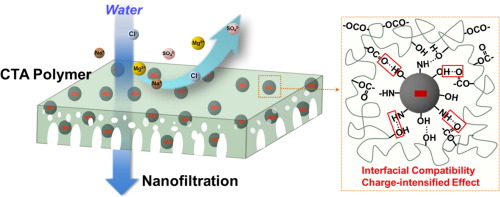Separation and Purification Technology ( IF 8.6 ) Pub Date : 2020-03-06 , DOI: 10.1016/j.seppur.2020.116816 Xiangju Song , Yajing Zhang , Yuchao Wang , Minghua Huang , Saeed Gul , Heqing Jiang

|
Nanomaterials incorporation in polymer membranes has been widely recognized as an effective strategy to improve membrane performance in filtration such as desalination. However, the poor compatibility between nanomaterials and polymer matrix restricts the enhancement of rejection because of unavoidable defects. In this work, we present a nanocomposite membrane by incorporating a kind of well-compatible polymeric nanomaterial, dopamine-melanin nanospheres with functional groups in cellulose triacetate (CTA) to improve the separation performance. The abundant amine and hydroxyl groups of dopamine-melanin nanospheres, not only contribute to the increase of membrane hydrophilicity for enhancing water flux, but also improve the interfacial compatibility between dopamine-melanin nanospheres and CTA matrix for maintaining excellent rejection. More significantly, the negative charges of dopamine-melanin nanospheres intensify the zeta potentials of membrane, which enhances the salt rejection by Donnan effect. The optimal NC-0.4 membrane yielded water flux of 22 L m-2 h-1 and high rejections to salts, MgSO4 (97.6%) > Na2SO4 (96.5%) > MgCl2 (91.8%) > NaCl (76.1%), owing to the synergistic effect of size exclusion and electrostatic repulsion. Moreover, the NC-0.4 membrane obtained excellent rejections to monovalent and bivalent ions. Therefore, blending well-compatible polymeric nanomaterials with polymer matrix could be an effective strategy to develop high-performance membrane for desalination.
中文翻译:

嵌入多巴胺-黑色素纳米球的纳米复合膜可增强界面相容性和纳滤性能
掺入聚合物膜中的纳米材料已被广泛认为是提高过滤(如脱盐)中膜性能的有效策略。然而,由于不可避免的缺陷,纳米材料与聚合物基体之间的不良相容性限制了拒绝率的提高。在这项工作中,我们通过在纤维素三乙酸酯(CTA)中引入一种具有良好相容性的聚合物纳米材料,具有官能团的多巴胺-黑色素纳米球来提出一种纳米复合膜,以提高分离性能。多巴胺-黑色素纳米球中丰富的胺基和羟基,不仅有助于增加膜的亲水性以增强水通量,而且还改善了多巴胺-黑色素纳米球与CTA基质之间的界面相容性,从而保持了优异的排斥性。更重要的是,多巴胺-黑色素纳米球的负电荷增强了膜的Zeta电位,从而增强了Donnan效应的除盐能力。最佳NC-0.4膜的水通量为22 L m-2 h -1和对盐的高排斥率,由于尺寸排阻和静电的协同作用,MgSO 4(97.6%)> Na 2 SO 4(96.5%)> MgCl 2(91.8%)> NaCl(76.1%)排斥。而且,NC-0.4膜对一价和二价离子具有出色的排斥性。因此,将相容性良好的聚合物纳米材料与聚合物基质共混可能是开发用于脱盐的高性能膜的有效策略。


























 京公网安备 11010802027423号
京公网安备 11010802027423号